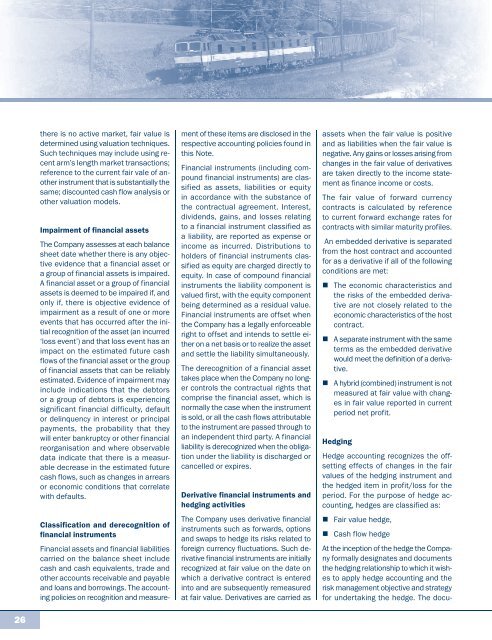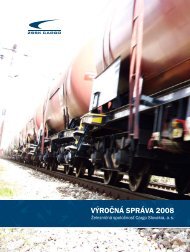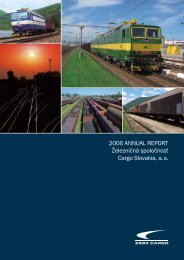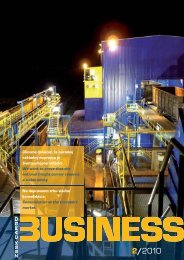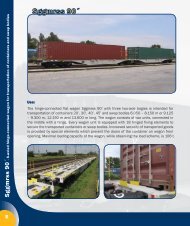AnnuAl report 2010 - ZSSK Cargo
AnnuAl report 2010 - ZSSK Cargo
AnnuAl report 2010 - ZSSK Cargo
Create successful ePaper yourself
Turn your PDF publications into a flip-book with our unique Google optimized e-Paper software.
there is no active market, fair value is<br />
determined using valuation techniques.<br />
Such techniques may include using recent<br />
arm’s length market transactions;<br />
reference to the current fair vale of another<br />
instrument that is substantially the<br />
same; discounted cash flow analysis or<br />
other valuation models.<br />
Impairment of financial assets<br />
The Company assesses at each balance<br />
sheet date whether there is any objective<br />
evidence that a financial asset or<br />
a group of financial assets is impaired.<br />
a financial asset or a group of financial<br />
assets is deemed to be impaired if, and<br />
only if, there is objective evidence of<br />
impairment as a result of one or more<br />
events that has occurred after the initial<br />
recognition of the asset (an incurred<br />
‘loss event’) and that loss event has an<br />
impact on the estimated future cash<br />
flows of the financial asset or the group<br />
of financial assets that can be reliably<br />
estimated. Evidence of impairment may<br />
include indications that the debtors<br />
or a group of debtors is experiencing<br />
significant financial difficulty, default<br />
or delinquency in interest or principal<br />
payments, the probability that they<br />
will enter bankruptcy or other financial<br />
reorganisation and where observable<br />
data indicate that there is a measurable<br />
decrease in the estimated future<br />
cash flows, such as changes in arrears<br />
or economic conditions that correlate<br />
with defaults.<br />
Classification and derecognition of<br />
financial instruments<br />
Financial assets and financial liabilities<br />
carried on the balance sheet include<br />
cash and cash equivalents, trade and<br />
other accounts receivable and payable<br />
and loans and borrowings. The accounting<br />
policies on recognition and measurement<br />
of these items are disclosed in the<br />
respective accounting policies found in<br />
this Note.<br />
Financial instruments (including compound<br />
financial instruments) are classified<br />
as assets, liabilities or equity<br />
in accordance with the substance of<br />
the contractual agreement. Interest,<br />
dividends, gains, and losses relating<br />
to a financial instrument classified as<br />
a liability, are <strong>report</strong>ed as expense or<br />
income as incurred. Distributions to<br />
holders of financial instruments classified<br />
as equity are charged directly to<br />
equity. In case of compound financial<br />
instruments the liability component is<br />
valued first, with the equity component<br />
being determined as a residual value.<br />
Financial instruments are offset when<br />
the Company has a legally enforceable<br />
right to offset and intends to settle either<br />
on a net basis or to realize the asset<br />
and settle the liability simultaneously.<br />
The derecognition of a financial asset<br />
takes place when the Company no longer<br />
controls the contractual rights that<br />
comprise the financial asset, which is<br />
normally the case when the instrument<br />
is sold, or all the cash flows attributable<br />
to the instrument are passed through to<br />
an independent third party. a financial<br />
liability is derecognized when the obligation<br />
under the liability is discharged or<br />
cancelled or expires.<br />
Derivative financial instruments and<br />
hedging activities<br />
The Company uses derivative financial<br />
instruments such as forwards, options<br />
and swaps to hedge its risks related to<br />
foreign currency fluctuations. Such derivative<br />
financial instruments are initially<br />
recognized at fair value on the date on<br />
which a derivative contract is entered<br />
into and are subsequently remeasured<br />
at fair value. Derivatives are carried as<br />
assets when the fair value is positive<br />
and as liabilities when the fair value is<br />
negative. any gains or losses arising from<br />
changes in the fair value of derivatives<br />
are taken directly to the income statement<br />
as finance income or costs.<br />
The fair value of forward currency<br />
contracts is calculated by reference<br />
to current forward exchange rates for<br />
contracts with similar maturity profiles.<br />
an embedded derivative is separated<br />
from the host contract and accounted<br />
for as a derivative if all of the following<br />
conditions are met:<br />
• The economic characteristics and<br />
the risks of the embedded derivative<br />
are not closely related to the<br />
economic characteristics of the host<br />
contract.<br />
• a separate instrument with the same<br />
terms as the embedded derivative<br />
would meet the definition of a derivative.<br />
• a hybrid (combined) instrument is not<br />
measured at fair value with changes<br />
in fair value <strong>report</strong>ed in current<br />
period net profit.<br />
Hedging<br />
Hedge accounting recognizes the offsetting<br />
effects of changes in the fair<br />
values of the hedging instrument and<br />
the hedged item in profit/loss for the<br />
period. For the purpose of hedge accounting,<br />
hedges are classified as:<br />
• Fair value hedge,<br />
• Cash flow hedge<br />
at the inception of the hedge the Company<br />
formally designates and documents<br />
the hedging relationship to which it wishes<br />
to apply hedge accounting and the<br />
risk management objective and strategy<br />
for undertaking the hedge. The docu-<br />
26


